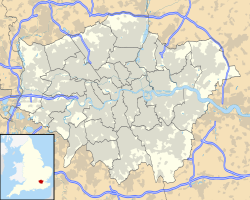East India Docks
Location of the East India Docks in Greater London |
The East India Docks were a small group of docks near Blackwall in London's East End . They were north of the Isle of Dogs .
history
After the successful creation of the West India Docks in 1802, a law in 1803 created the East India Dock Company , which was supported by the East India Company .
The docks were northeast of the West India Docks. They were based on the pre-existing Brunswick Dock , which was used for ship equipment and repairs as part of Blackwall Yard . Brunswick Dock, the south end of which was originally directly connected to the Thames , became the Export Dock . To the north of it, the company built a larger, 73,000 m² import dock . Both were connected to the Thames by an entrance basin to the east.
The company quickly became profitable with goods such as tea, spices, indigo, silk and Persian carpets. The tea trade alone was £ 30 million a year. The port facilities attracted further industrial companies, spice dealers and pepper mills settled in the vicinity of the port and processed the goods.
In 1838 the East India Company and the West India Company merged. 1886 they built in a last act of ruinous leapfrog with the London & St. Katherine Dock Company , the Tilbury Docks . In 1909 the port facilities were taken over by the Port of London Authority along with the other port facilities on the Thames.
Although the East India Docks were much smaller than the West India Docks or the later Royal Docks , they could accommodate East Indiamans with up to 1,000 GRT and 250 ships at a time. However, the emergence of steamships and the increase in the displacement of these ships made the importance of these docks dwindle and in the middle of the 20th century most of the trade was carried out elsewhere.
The port played a key role in World War II as it was where the Mulberry floating ports were built, which the Allies used to support the D-Day landing operation in France.
After the war, in which all port facilities were badly damaged, only the occasional traffic to the Channel Islands was handled from the East India Docks and tugs etc. were serviced and repaired there.
The Brunswick Wharf Power Station (coal-fired power station) was built on the site of the Export Dock in stages between 1946 and 1956. It was a monumental brick building with concrete chimneys in the style of Giles Gilbert Scott's design for the Battersea and Bankside power plants . The power plant ceased operations in 1984 and was demolished in the late 1980s.
The East India Docks were among the first port facilities in London to be closed. That was in 1967.
East India Docks today
Today most of the harbor basins are filled. Only the entrance basin is left and serves as a nature reserve and recreational area. The area is mainly built up with residential houses; a number of urban development projects have been carried out there or are in progress. One on the Leamouth peninsula will serve as the western end of the port and will be ready in 2012.

